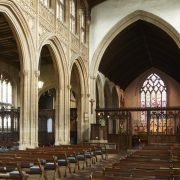The challenges of managing historic parish churches
England is known for having an amazing heritage, and part of its heritage is historical parish churches. Historic England is working towards understanding the special challenges that people face in caring for this type of place of worship in today’s society.
Although there are more than 200 historic parish churches in England with a floor space of more than 1000m2, no research had ever been done to try to understand if there are any opportunities or challenges that make them easier or harder to maintain than the 14,790 smaller listed places of worship, until now.
Historic England, Heritage Lottery Fund, the Church Buildings Council, the Greater Churches Network and Doncaster Minster have created a partnership project to gain an understanding of this church type.
- The research involved a sample of large buildings representing sites across England, carefully selected and dating from different periods and servicing different communities. A number of other churches were also included to be able to provide parallel data, which, although smaller in size, are just as significant due to their history and expectations placed upon them.
- It focuses on very significant buildings used by the nation and community; ones that are expected to provide services and functions beyond those of a typical parish church (i.e. cultural, ecclesiastical, civic, tourism, etc.) but with just the resources of a parish church.
- The research undertaken explore today’s physical condition and the resources available to manage, repair, maintain and sustain larger historic churches.
The project started in October 2015 when Historic England invited 80 sample parishes and Church of England dioceses to complete short questionnaires, covering five topics:
- Attitudes towards the buildings
- Who contributes to the care of the buildings and takes responsibility
- How they welcome visitors
- Making changes to accommodate new facilities or activities
- Finances and funding
Fifty of those who completed the questionnaires were invited to participate in a follow-up telephone interview, and each building was the focus of a small case study. Following from this, twelve churches were chosen for a more detailed investigation, for a cross-section illustration of locations, experiences, roles and ministries. The representatives of the twelve churches undertook further interviews to provide deeper information of the daily opportunities and challenges associated with the use of these buildings. The project partners are indebted to everyone who took part in this research.
You can find out more about the project by watching this full film.






Leave a Reply
Want to join the discussion?Feel free to contribute!